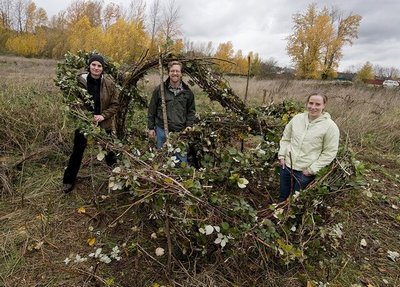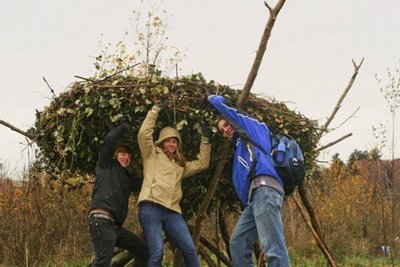December 3, 2009
Make art, not yard waste, ecological restoration students learn
When life hands you brambles, make art.
That’s what two UW classes interested in ecological restoration did after clearing Himalayan blackberry canes from areas of the Union Bay Natural Area, a part of the UW Botanic Gardens on Lake Union.
One class wrestled the canes into interlocking rings and created a seven-foot tall sphere, which later relaxed toward the ground, while the other constructed a huge bird’s nest.
There have been different approaches to public art that incorporates the natural environment. Some artists sculpt and alter the landscape. Others think environmental art, also called such things as “eco-art” and “earthworks,” should be more about improving people’s relationship to the natural world by, for example, restoring damaged areas and incorporating artistic expression in the process.
That’s why Jon Bakker, assistant professor with the School of Forest Resources, wanted students in his “Introduction to Restoration Ecology” class to do a project with Amy Lambert, a lecturer at UW Bothell who earned her master’s in forest resources from the UW. Lambert is teaching a course this fall on art and restoration.
Environmental art is a natural fit, given the varied interests of Bakker’s students. The course is among those offered by units in the newly formed UW College of the Environment, and is an example of the broad interdisciplinary potential of the college’s environmental and natural resources curricula. The 58 students in Bakker’s course, for example, represent five majors in the college and 12 other UW majors, ranging from anthropology to civil engineering.
“During the work, students were exposed to the possibilities of combining restoration activities with art — and with other pursuits in the future as well,” Bakker says. “We cleared a blackberry patch but, rather than hauling the blackberry canes away, they were left on the site as a visible sign to passers-by that something had happened here. Finally we gave students a challenging situation — thorny blackberries with a minimal number of tools — and asked them to work together to accomplish a larger task.”
The session involving environmental art was one of three hands-on labs during the course. The others involved students participating with EarthCorps in restoration activities in Interlaken Park and planting trees in the Union Bay Natural area.
Lambert’s restoration-art class worked at the Union Bay Natural Area and created their own blackberry cane art. They also created a performance art piece called Water Poles, that concerns the historical changes to the Union Bay area, including the construction in 1916 that caused the level of the bay to drop 11 feet, greatly altering the wetlands along the shore.
“The activities were about removing invasive species and transforming the material into sculptural forms,” Lambert says. “In addition, performance art was used to call attention to the historic context of Union Bay Natural Area. By engaging in inventive strategies, students demonstrated their concerns for the natural environment while challenging public perceptions
about the role humans have played in shaping the landscape.”




